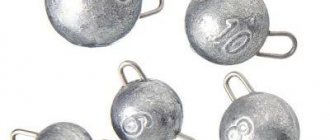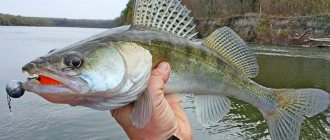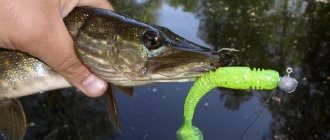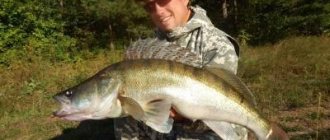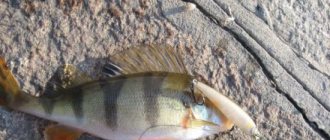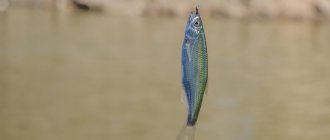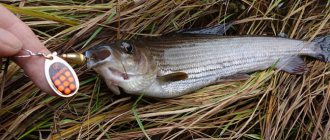The success of jig fishing depends not only on a properly selected spinning rod, but also on equipment, namely such an element as a jig head.
This small metal weight can change the course of even the most elusive fishing! Do you have any doubts? We will prove it. In this article, we will present the most complete theoretical basis with specific examples and tips on what a jig head is, what types they are classified into, we will indicate the important parameters of this element of jig equipment that should be taken into account when choosing a fishing spot, and we will show an interesting video. All you have to do is reinforce your theoretical knowledge with practice!
Content
- 1. What is a jig head
- 2. Types of jig heads
- 2.1 By weight
- 2.2 By material
- 2.2 In relation to the hook
- 3.1 Jig heads with hook and resistance property
- 3.2 Jig heads - non-hooking
- 3.3 Streamlined jig heads
- 3.4 Noise jig heads
What is a jig head
Jig head or the English equivalent of this concept jig-head is one of the types of sinkers used for jig baits when spinning jig fishing.
A sinker is an element of equipment whose purpose is to increase the weight of the fishing line and hook and deliver the bait to a given depth.
Read the most detailed information about monofilament fishing line, its characteristics, installation methods, storage and care here
Thus, a jig head is a sinker that has a certain shape, to which a hook is attached (or not attached). The name “head” appeared due to the fact that the sinker is fixed in the head part of the bait and connected to it into a single structure.
Area of use : all types of fishing with jig baits. The type of fishing rod used is a spinning rod.
Jig head color
Previously, everything was caught quite well with ordinary lead weights, and they were not painted in any colors. Afterwards, manufacturers began to produce sinkers painted in dark matte colors, citing the fact that the lack of glare reflected by ordinary lead does not frighten the fish so much, increasing the number of bites.
Nowadays, in the kit of many athletes you can find a jig weight painted red, pink, orange or another color. They motivate this by the fact that a painted sinker can provoke fish to bite. My recommendation to you is that you should not overpay extra money for the fact that your jig head will have a color.
Types of jig heads
2.1 By weight
According to this parameter, this equipment element is divided into the following types:
- for fishing with nanojig style – weight up to 3 g;
- for microjig fishing – weight from 3 to 7 g;
- light – from 7 to 21 g;
- medium - from 21 to 42 g;
- heavy - 42 grams or more.
This parameter is important when fishing at depth and in reservoirs of different current speeds. Also, the weight of the cargo is determined based on the characteristics of the spinning rod and the size of the future prey.
Examples of using weights under various fishing conditions:
- Standing water and a depth of 2 m - the weight of the head is taken to be 2 or 3 g. The stronger the water flow and depth, the weight of the load must be increased accordingly.
- Depth 6 m with current at a speed of 3 m/s – weight 30 – 45 g.
- Depth 4 m and current up to 2 m/s - weight from 12 to 15 g.
- Large pool and depth from 4 to 6 m - weight from 10 to 14 g.
- Depth from 6 to 10 m – weight from 14 to 20 g.
- Depths greater than 10 m require the use of weights ranging from 18 to 30 g.
Weight is an important parameter that affects the diving speed, depth and casting distance. It is believed that when choosing a weight, one should be guided by the time (speed) of deepening the load, which on average should be from 2 to 5 s. In this case, it is worth taking into account the natural factors of the reservoir and terrain, which can reduce or increase this time. You always need to experiment.
Useful video on how to select weight depending on the depth of the reservoir (author of the “Fishing PRO” channel)
Advice: for beginner spinning anglers, the optimal weight is considered to be sinkers from 1.5 to 3.5 g. This weight should be tested at short distances, feeling the behavior of the sinker in the water. Then choose a sinker with a suitable weight.
2.2 By material
Jig heads made of lead metal have gained popularity in fishing due to their affordable price, availability of the metal itself and ease of processing, which allows any interested angler to easily make such an element of equipment at home. The downside is that over time the cargo begins to oxidize and become covered with a white coating.
One of the ways to eliminate this drawback is offered by the DEEVER channel - fishing with DEEVER
Tungsten - are made not from pure tungsten, but from an alloy that includes this metal.
Advantages of tungsten:
- metal has an advantage in weight category in relation to lead;
- tungsten heads are much more compact than lead ones (if you take each element in the same weight), this affects the casting distance;
- more durable ones, for example, retain their shape when hit by stones;
- good sound animation, which appears when you tap on stones, which attracts fish in troubled water
The disadvantage is the high price.
Sinkers made of brass are used in fishing, but this is not a practical alloy, which, due to its soft qualities of the material, quickly becomes unusable.
2.3 In relation to the hook
Jig heads equipped with a “bait holder” hook are distinguished by the fact that they have a hook in the form of a ring in the upper part of the head structure and a latch that serves as a stopper and has a variety of shapes. The stopper's job is to prevent the bait from falling off the hook. A jig head with a specific shape lock is selected according to the weight, length of the bait and fishing conditions. For example, when microjigging, heads with a spherical-shaped lock are predominantly used or dispensed with without it.
a — a retainer in the form of a “spike” or “needle”; b - “ball”; c - “mushroom” (umbrella); g - “arrows”; d - without lock.
The characteristics of the hook should also be taken into account. So, when catching a large predator, it is better to use hooks made of wire of a larger diameter, and hooks made of thin material are better used in snags, since they can easily unbend when unhooked.
Important! The size of the hook for a jig sinker depends on the specific bait, its size, shape, etc. So, with large baits, large hooks are used and vice versa. You should also take into account the fishing location (a clean reservoir or with vegetation and stones), and the activity (behavior) of the predator. Large hooks allow you to successfully complete most bites, but also affect the number of hooks and vice versa.
Hooks for jig heads can have the following numbering:
- from No. 10 to No. 1, where the 10th number is the smallest hook;
- from No. 1/0 to No. 5/0, where No. 1 is the smallest hook in size.
Important! Different manufacturers number their products differently.
Jig heads with no hook or separate ones. This type of sinker is equipped with two eyes, a hook with an attachment is attached to one (for example, through a ring or directly to the eye), and to the other - a fishing line.
Jig heads with ears are popularly called a Cheburashka sinker. This type of sinker has found its application in microjig fishing and more.
There are other forms of double eye sinkers, such as
Stationary jig heads
Stationary jig heads require a rigid connection between the hook and the load. Such jigs were the very first to appear, and for a long time were considered “classics of the genre.” But even now, with the advent of hinges, stationary jig heads have not disappeared from jig boxes. And that's why. Thanks to the rigid connection, the hook threaded into the body of the silicone bait is almost always positioned with the tip up.
But this is the position of the hook that is most successful for the most effective hooking. And during wiring, the so-called “sticking” of the hook in the weight ring will never occur, during which the effectiveness of the animation will sharply decrease. On stationary installations, the game turns out to be more measured, smooth and without glitches. Very often this is exactly what a predator needs.
There are also a number of baits, the best qualities of which are revealed only on stationary jigs. You can never read this on the packaging, but even with a little experience you can understand which bait is best to put on which rig. However, this is far from the most decisive factor, and it is better for a beginner not to start with this. Understanding such subtleties will come with experience.
Stationary jig heads, other things being equal, are also good to use in situations where a predator attacks baits “in the air” without really studying them before throwing. This “study” is typical mainly for perch and pike perch. They sometimes only decide to attack when the jig lies on the bottom and the bait falls after it. Here the stationary installation will already lose to the hinged one.
Indeed, in this case, the fish will have to pick up the bait along with the load, and this always causes great distrust and suspicion. There is not a single living object in reservoirs that has the density of lead, much less tungsten. The pike is another matter. Almost all of its attacks occur while the bait is hovering in the water column (mainly near the bottom) and the mass of the jig will not have a strong effect here. This means that a classic jig head is perfect.
Naturally, stationary jig heads have other disadvantages. Firstly, due to the high drag of the rigid connection, the casting range is noticeably reduced. Secondly, for the same reasons, such installations take longer to sink to the bottom (although this is often a plus). Thirdly, we do not have the opportunity to vary the size of baits - we only put the one that fits the hook of a given jig head. Fourthly, in some situations when fishing, a fish can free itself from the hook using a rigid connection as a lever. Most of these shortcomings are eliminated by the second, much younger method of attaching the hook and load - hinged.
Types of hooks
- Jig heads with one hook. Scope of application: microjig. The equipment comes in combination with an eared weight, a pellet on a fishing line when fishing using a leash or without a leash. A special feature of single baits is that they can have from one to several notches on the fore-end, which affects the quality of the bait’s attachment.
- Jig heads with doubles. This type of sinker is used when equipped with eared weights. Typically, doubles are taken with a long fore-end for ease of mounting the bait.
- Jig head with offset machine. An offset hook is one that has a certain shape on the bend of the fore-end. Such hooks are good for creating rigs with “non-snag” baits. They are used when fishing in snags and grass. Offset hooks can also be used in conjunction with an eared weight.
Read everything you didn’t know about the retractable leash here
Types of Jig Head Hooks
Single
Jig heads with single hooks are the most common type of jig heads (second most popular are snap-on jig heads with offset hooks). Ordinary singles are also used in microjigs together with an eared sinker, with a pellet sinker located on the fishing line, when fishing with lead rigs and when fishing without weight. When using a single hook instead of a double hook, the number of snags on grass and snags is significantly reduced, and the hook gets caught in the fishing line less often during casting. Singles used in jig heads can have one, two or three notches on the fore-end, thanks to which the bait stays better on the hook and does not slip.
Double
Doubles are the main type of hook used in jig fishing with eared sinkers. When fishing with silicone baits or foam fish, double hooks can be left open; the use of non-snacking baits, which are made from foam rubber and double hooks with hooks pressed to the body of the foam rubber fish, is also widespread. In jig fishing, doubles with an extended forearm are usually used, with which the installation of jig baits is as convenient as possible.
Offset
Offset hooks are specially shaped hooks with a bend on the fore-end, which are designed to create non-snagging baits. Offset hooks are optimal for fishing both in thick snags and among grass thickets and in other strong places. On sale you can find jig heads with offset hooks; in addition, offset hooks are used in combination with eared sinkers.
Dimensions
The hook size in jig fishing is selected according to the size of the bait. In addition, you should take into account the fishing conditions (how often snags occur) and the activity of the fish. Larger hooks provide a high percentage of bites, but also give a large number of hooks on grass, snags and other obstacles. The use of smaller hooks reduces the number of hooks and leads to an increase in the number of derailments. The following numbering of hooks for jig fishing is common: No. 10, 9, 8, 7, 6, 5, 4, 3, 2, 1, 1/0, 2/0, 3/0, 4/0, 5/0. In this row, hook number 10 is the smallest, and 5/0 is the largest. It should be noted that different companies designate the sizes of hooks they produce differently; for example, the Eagle Claw numbering differs from the Cannelle and VMC numbering.
What are balanced and unbalanced jig heads?
Any jig sinker is equipped with a ring. For balanced heads, such a ring is located in the central part of the load, which allows you to hang on the thread in a horizontal position. When retrieving, at the moment of reeling, the fishing line bends slightly forward, and when stopping, it immediately rushes down. This is convenient for stepped wiring style.
Unbalanced - when reeling in, they swim horizontally, and at the moment of a pause they slowly sink. It is better to use such weights when fishing in shallows with long casting and a uniform fishing style.
Selection of the mass (weight) of the jig head for fishing conditions (river, pond, reservoir)
I’m sure that even a beginner understands that an incorrectly selected jig weight can practically reduce all the fisherman’s efforts to zero. But it is completely wrong for a beginner to be afraid - this is only possible with an absolutely illiterate approach to the situation.
Of course, it is impossible to accurately determine the optimal weight of a jig head before the start of fishing, however, based on the expected fishing conditions, it is possible to correctly predict the range of weights that, at least, will not bring a fiasco. And also, it will allow you not to carry around mountains of excess lead or tungsten. However, each type of reservoir has its own selection rules. Let's look at them in more detail.
Choosing a jig head on the river
On the river, in addition to the depth, the required casting distance, the type of bait used and, of course, gear, one should also take into account the strength of the current. Despite the fact that the river is the most difficult option, let's start with it.
It is known that the main task of a jig head is to provide the required fishing horizon for the bait. And also - allow the bait to hover above the bottom for some time. It is believed that for a standard step-by-step retrieve, the time the bait falls should be on average 2-3 seconds. In most cases, this will be the optimal weight of the jig. Of course, the weight is selected experimentally, but for most small and medium-sized lowland rivers with depths from 2 to 5 meters, the required weights range from 8 to 16 grams.
And the weight of the jig head also depends on the type of predator that you have to hunt, or rather, on the bait that he likes most. But here too everything is predictable. For example, for perch the standard size of lures is 2-3 inches, therefore, jigs will need an average of 4-8 grams.
For river pike, baits of 3-5 inches in size and weight of 8-18 grams are usually used. River pike perch are more interested in 3-4 inch models and wires near the bottom, so heads of 12-18 g will be the most suitable. The given figures refer to hinged installations. For stationary jig heads, the values should be increased by 15-20%.
One of the serious problems for a beginning spinning angler when fishing on a river is the constant change in fishing conditions. After all, even within the same wiring there are holes and shallow waters. This sometimes confuses even an experienced fisherman, let alone a beginner. Of course, it is stupid to change the jig before each cast. But this is not necessary.
First, we need to decide whether we are betting on grassy shallows or holes. Secondly, it is often possible to select some kind of averaged (universal) option, suitable for both deeper and shallower areas. Thirdly, by changing the casting vector, you can achieve the desired pause (2-3 seconds) at different depths without changing the jig.
For example, casting with the current, and therefore wiring against it, allows you to increase the flow resistance by about 20-30%, and you won’t have to set a lighter jig. In the same way, wiring with the current (“upstream”) gives a gain in weight by the same 20-30%. That is, where casting a jig of 10 grams perpendicular to the current carried away like wood chips, and 12-14 grams were required, casting with the current will allow you to fish comfortably with 10 grams.
Choosing a jig head on a pond
On the pond the situation is much simpler. There is no current here, and even sudden changes in depth are extremely rare. Therefore, the optimal jig size will mainly depend on the depth and required casting distance (if fishing from the shore). And we can know this data before fishing. The main requirement is the same - it is necessary to achieve a pause on step-by-step wiring of at least 2 seconds.
Practice says that in most small closed reservoirs, both perch, pike, and pike perch prefer medium-sized baits. This means that, to a first approximation, the dependence of the optimal jig head mass on depth will look like this:
a) depth up to 2 m – jigs 2-6 g;
b) depth 2-4 m – jigs 5-10 g;
c) depth 4-6 m – jigs 8-12 g;
d) depth from 6 m – jigs 12-18 g.
Choosing a jig head for a reservoir
The reservoir also has its own specifics. And it is connected with the fact that in large expanses of water fishing is almost always done from a boat. But if you are fishing from the shore, then all the recommendations outlined for pond fishing will be completely relevant.
It is known that boat jig fishing involves mainly searching for bottom anomalies (sharp changes in depth, holes, spits, channel boundaries, etc.), where the predator is most often concentrated. In this case, the mass of the jig head should be such that it can fully fish both the lower part of the dump (depth) and the upper part (shallow).
Since boat fishing rarely involves “persuading” a passive predator to bite, but, on the contrary, focuses on active specimens, there is no need to waste time with the weight of the jig. The same can be said about the size of the bait - in deep water it should also be large (usually 4-5 inches). There is no need for long casts; when fishing from a boat, they are rarely practiced.
Thus, an approximate selection of jig weight depending on depth will look like this:
a) depth up to 2 m – jigs 4-8 g;
b) depth 2-4 m – jigs 6-12 g;
c) depth 4-6 m – jigs 10-14 g;
d) depth 6-10 m – jigs 14-20 g;
d) depth from 10 m – jigs 18-30 g.
useful links
https://spinninglive.com.ua/elementyi-spinningovyih-osnastok/svinets-protiv-volframa-v-lovle-dzhigom.html - an article about a comparison of two metals: lead and tungsten. Which is better?
https://ulovmesto.ru/dzhig-golovki/ - detailed article about the types and shapes of jig heads;
https://viktor-andreev.ru/spinning-dzhig-golovki-gruz-golovki-vidy-1105.html - Viktor Andreev about jig heads;
https://ru.wikipedia.org/wiki/Jig head - an encyclopedic article about jig heads.
